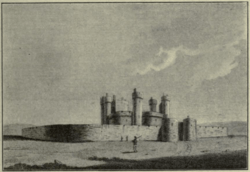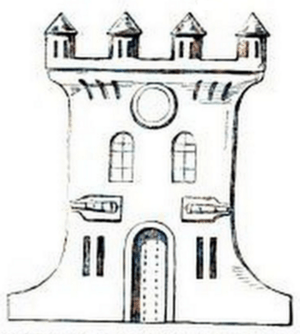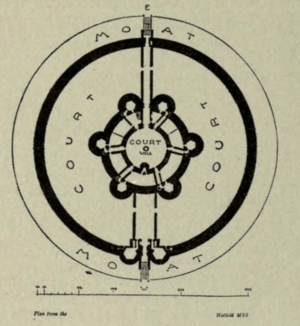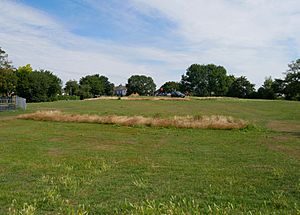Queenborough Castle facts for kids
Quick facts for kids Queenborough Castle |
|
|---|---|
| Queenborough, England | |

An 18th-century engraving of Queenborough Castle, based on a lost drawing by
Wenceslaus Hollar (1607-1677). |
|
| Coordinates | 51°24′58.32″N 0°44′55.17″E / 51.4162000°N 0.7486583°E |
| Type | Concentric castle |
| Site information | |
| Open to the public |
Yes |
| Site history | |
| Built | 1361-1367 |
| Demolished | 1650 |
| Events | Hundred Years' War Jack Cade's Rebellion |
Queenborough Castle, also known as Sheppey Castle, was a strong castle built in the 1300s. Its remains are found in the town of Queenborough on the Isle of Sheppey, Kent, England. King Edward III ordered its construction starting in 1361. He named it Queenborough to honor his wife, Queen Philippa.
This castle was special because it was the first "concentric castle" built in England. This means it had walls within walls, like a target. It was also the only new royal castle built in England during the Late Middle Ages. Queenborough Castle overlooked the Swale, an important waterway leading to the River Medway. It helped protect England's coast until 1650. At that time, it was decided the castle was no longer useful and was mostly torn down. Today, the site is a public park, and only small earth mounds remain.
Contents
History of Queenborough Castle
Why Was the Castle Built?

The story of Queenborough Castle began in 1361. King Edward III bought land on the Isle of Sheppey. This land was near a small fishing village called Bynne. Two houses on the site had to be removed, and their residents found new homes.
The castle's main purpose was "for the defence of the realm." This meant it would protect the country. It also offered "refuge for the inhabitants of the island." The 1360s were a time of uneasy peace during the Hundred Years' War. This peace came after the Treaty of Brétigny in 1360. Some people think the new castle was also a "palace-fortress." This would be a safe place for the royal family to escape the Black Death. This terrible sickness had reached England a few years earlier.
However, the castle's location was very important. It controlled where the Swale and River Medway met. This was a key route into the Thames Estuary. Also, Hadleigh Castle on the other side of the Thames was being fixed up at the same time. This shows that the castle had a military purpose. French raiders had also attacked southern ports like Rye and Winchelsea in 1360.
Building the Castle
Many skilled workers helped build Queenborough Castle. Master builders like John Box, Henry Yevele, or William of Wykeham may have led the project. About 1,600 craftsmen and laborers worked on it. The castle was finished around 1367 and cost about £20,000.
The castle had a new and unusual design. It was the first "concentric castle" built in England. It had a large round main building, like a rotunda or a "shell keep." This building had six towers sticking out from it. In the middle was a circular courtyard. A second, outer circular wall surrounded this main building. There was also a moat around the entire castle. Some believe the design was inspired by Bellver Castle in Mallorca, built earlier.
Queenborough was one of the first English castles made to stand against "siege artillery." These were large cannons used to attack castles. It could also fire its own guns. It was the last royal castle built in England during the Late Middle Ages. At first, rainwater from the roofs was collected in tanks. Later, in 1393, a deep well was dug in the courtyard for water.
Life at the Castle (14th to 16th Centuries)
The first "constable" (the person in charge) of the castle was chosen in 1365. This was even before the castle was fully built. He was told to arm it and make it ready for defense. In the same year, "two great guns and nine small ones" were sent to Queenborough. These came from the cannon factory at the Tower of London. This shows how important Queenborough was, even more than Dover Castle at that time.
After the castle was finished, King Edward III visited it. He gave a special document, a royal charter, to the new town being built nearby. He named the town Queenborough to honor his wife, Philippa. Being the Constable of Queenborough Castle was a very important job. Famous people held this position. These included John of Gaunt (from 1377) and George Plantagenet, 1st Duke of Clarence (from 1461). King Edward III often stayed at Queenborough during his later years.
On April 21, 1450, a French force attacked Queenborough Castle. In July of the same year, Jack Cade and his rebels also attacked. The castle easily fought them off, and Cade himself was hurt. King Henry VIII repaired the castle in 1536. A report from 1629 mentions seeing the coat of arms of Queen Elizabeth I on a wall inside the castle. It had a Latin poem praising her.
The Castle's End (17th to 19th Centuries)
During the English Civil War, supporters of the King held Queenborough Castle. But after King Charles I was executed in 1648, the castle came under the control of the Commonwealth. In 1650, Parliament sent people to check on properties they had taken from the crown.
Their report said Queenborough Castle was "much out of repair." It was "no ways defensive" for the Commonwealth. They decided it was "not fit to be kept, but demolished." The castle was sold to a man named John Wilkinson for £1,792, twelve shillings, and one halfpenny. He tore down the entire castle, even its foundations, and sold the materials.
In 1723, the Royal Navy checked the castle's well, which had survived. They found it was 200 feet (61 meters) deep and lined with Portland stone. After making it deeper, they could get "good, soft, sweet and fine" water. This water was used for the dockyard at Sheerness. In 1860, a railway line opened, cutting through the eastern part of the castle site. A pump house was built over the well to get water for locomotives. A school was also built on the western side of the site.
What Queenborough Castle Looked Like

We know what Queenborough Castle looked like from a few sources. There is a plan in an old manuscript at Hatfield House. There is also a drawing by Wenceslaus Hollar (1607-1677), though the original is lost. We know it from copies made in the 1700s. The most detailed description comes from the 1650 report by the Parliamentary Commissioners.
The main round building, the rotunda, had a paved courtyard in the middle. The "great well" was in the center of this courtyard. The outside wall of the rotunda had six round towers. Two of these towers guarded the main entrance on the eastern side. The Commissioners reported that the rotunda had twelve rooms "downstairs." It also had "about forty rooms from the first story upwards."
About 30 yards (27 meters) away from the rotunda was another plain circular wall. This was the "curtain wall," and it enclosed an outer area called a bailey or outer court. This outer wall had only two towers. These towers formed a gatehouse for the main entrance on the western side. This meant that if attackers broke through this gate, they would still have to go around the bailey to find the rotunda's entrance. A large circular moat surrounded the curtain wall.
Opposite the rotunda's entrance was a "postern." This was a small, secret gate for people walking. The postern and the main gate were connected to the rotunda by walled paths. These paths divided the bailey. Castle records show that two stone buildings were built in the bailey between 1369 and 1377. We don't know what they looked like or what they were used for. Records also suggest the castle had a fish pond and a garden. The Commissioners estimated the whole castle covered "upwards of three acres of land."
Finding Out More: Archaeology
The first time archaeologists dug at the site was in September 1991. This was done by the Canterbury Archaeological Trust. It happened before the car park was made bigger. They dug four trenches, but groundwater and rain made it hard. They believe they found the castle's moat during this dig.
The TV show Time Team also investigated the site in September 2005. This was shown in their episode "Castle in the Round." Wessex Archaeology recorded and studied the work. They tried a "geophysical survey," which uses special equipment to look underground. But this was difficult because of a concrete slab from the 1970s over the well. Clay soil, pipes, and an air raid shelter also got in the way.
However, digging trenches helped them find parts of the outer curtain wall. They found where it had been torn down and rubble pushed into the moat. They also found pieces of walls inside the bailey. These were likely from the walled paths leading from the gate. One trench found pieces of shaped stone and Flemish brick. These probably came from the main castle building. They also found sixteen small pieces of medieval pottery. Other finds included five coins and tokens, one a French "jeton" from the 1400s, and two musket balls.
Images for kids
-
Portrait of John of Gaunt, Duke of Lancaster. He was Constable of Queenborough Castle from 1377. This portrait was made around 1593 for Queenborough Castle. It was likely based on a lost statue of Gaunt.



